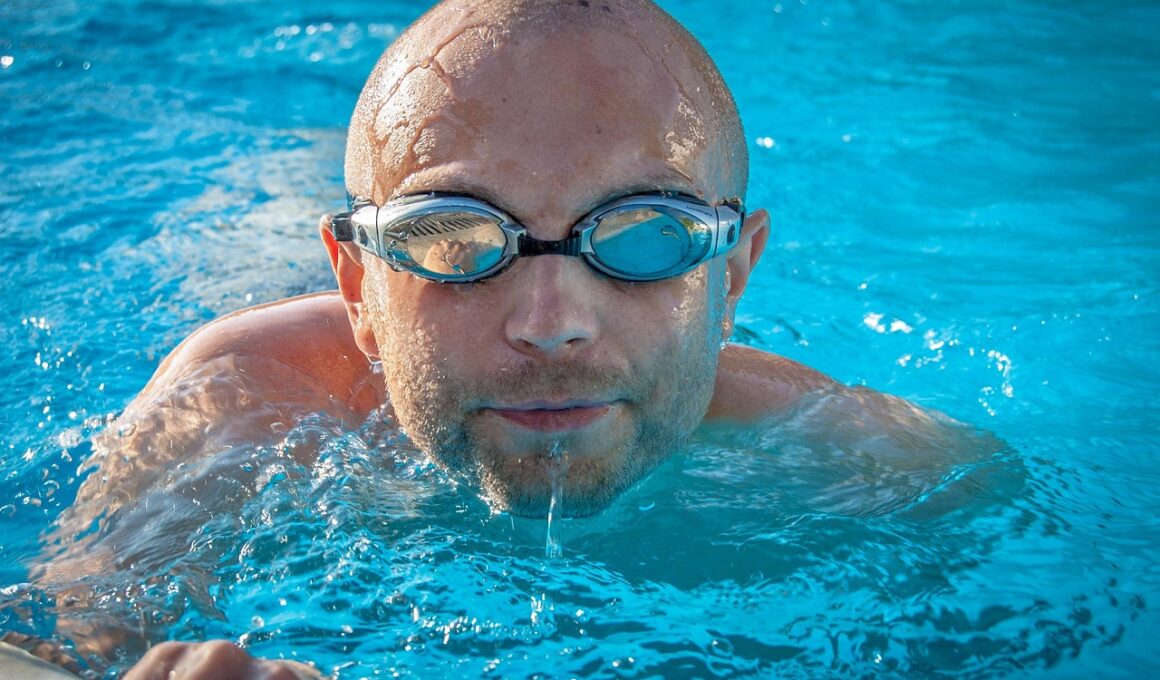Overcoming Barriers to Participation in Adaptive Swimming
Adaptive swimming is an essential activity that offers numerous benefits to individuals with disabilities. It fosters physical health, emotional well-being, and social connections. Participation in this empowering sport can lead to increased self-confidence and improved physical fitness. Despite these advantages, many potential participants face barriers that hinder their involvement. These barriers can include lack of access to appropriate facilities, insufficient programming tailored specifically for adaptive swimmers, as well as social stigma that discourages participation. It is paramount to address these challenges head-on, ensuring that individuals of all abilities can experience the joys of swimming. Access to knowledgeable instructors is crucial, as they are vital in providing safe environments and encouraging skill development. Collaboration among community organizations, swimming clubs, and families can create supportive networks, emphasizing the importance of inclusivity in aquatic activities. Furthermore, increasing visibility through awareness campaigns can help dismantle stereotypes surrounding disabilities and swimming. Engaging stories of successful adaptive swimmers can inspire others to participate, promoting a culture of acceptance and excitement within the sport. Ultimately, breaking down barriers in adaptive swimming leads to enriched lives and empowered individuals.
Creating a welcoming environment is fundamental in promoting adaptive swimming among individuals with disabilities. Swimming facilities must ensure that their premises are accessible, featuring ramps, pool lifts, and appropriate changing areas to accommodate all needs. Additionally, staff training is crucial for fostering understanding and empathy toward those with disabilities. When lifeguards and swim instructors are equipped with the knowledge to assist adaptive swimmers effectively, participants feel more confident and secure in the water. Program customization is equally vital; swimming programs should cater to various skill levels, body types, and abilities, ensuring participants receive the support they require to thrive. Approaches may vary from providing individual coaching to organizing group sessions where adaptive swimmers can connect and share experiences. Communication also plays a key role; engaging with potential participants to learn their needs and preferences can enhance program offerings. Creating a positive, non-judgmental atmosphere allows individuals to feel encouraged to explore swimming. Collaborative partnerships between adaptive sports organizations and local pools can create sustainable programs that foster community support while increasing participation rates. Together, these efforts enhance access and transform swimming into an inclusive sport enjoyed by everyone.
Technological advancements are significantly shaping the landscape of adaptive swimming, making participation more accessible. Innovations like specialized equipment, such as adaptive swim gear and flotation devices, are being developed to meet the diverse needs of swimmers. These advancements enable individuals with varying abilities to engage in swimming activities comfortably and safely. For instance, highly buoyant swim vests provide extra support for those with limited mobility, while streamline designs enhance performance for competitive swimmers. Moreover, the implementation of sensory-friendly swimming environments, such as quieter pool areas, benefits individuals with sensory processing difficulties. Awareness and research in adaptive equipment must continue to grow, enabling developers to design more effective tools that enhance user experience. Accessibility also encompasses the online space, as websites and apps can be optimized to provide information about adaptive swimming resources and events. These digital platforms can connect adaptive swimmers with local programs and coaches. Community support and involvement are crucial to capitalize on these opportunities. By fostering a collaborative spirit among manufacturers, aquatic facilities, and organizations, we can ensure that advancements in technology lead to increased participation rates for adaptive swimmers, ultimately transforming lives for the better.
The Role of Volunteerism in Adaptive Swimming
Volunteerism has a vital role in the promotion and sustainability of adaptive swimming programs. Volunteers can bring unique skills and energy, helping to create engaging and dynamic environments. Their dedication enables swimming programs to thrive, ensuring participants receive the individualized attention and support they need. By offering their time and resources, volunteers contribute to building strong communities centered on inclusivity and empowerment. Volunteer training workshops can familiarize them with the specific needs of adaptive swimmers, teaching essential techniques tailored to varying abilities. Training creates a foundation of camaraderie that fosters empathy and respect among participants and volunteers. This relationship can also help establish social connections and support networks among athletes, as they experience shared challenges and triumphs in the water. Furthermore, volunteers can assist coaches by providing encouragement and motivation during classes, enhancing the overall experience for adaptive swimmers. Community outreach programs can recruit more volunteers, promoting awareness of the benefits of adaptive swimming and its positive impacts on individuals’ lives. In turn, this engagement can inspire others to participate and contribute their time, creating a ripple effect in the community surrounding adaptive sports.
Marketing adaptive swimming programs effectively is essential to increasing awareness and participation. Utilizing various promotional strategies can attract diverse audiences, helping to break the stigma associated with disabilities in sports. One impactful approach is to leverage social media platforms to share stories from current participants. Showcasing personal journeys and triumphs not only promotes the program but also humanizes the experience for potential newcomers. Captivating visuals, such as photos and videos, can capture the excitement and joy adaptive swimmers feel during activities. Collaborating with local influencers or athletes can expand the outreach and create buzz around upcoming events. Participation in community events or exhibitions can also raise awareness while showcasing the benefits of adaptive swimming. Providing opportunities for individuals to try adaptive swimming can spark interest and encourage enrollment. Free trial sessions help potential participants experience firsthand the benefits of swimming, fostering inclusivity. Building strong relationships with schools, healthcare organizations, and disability advocacy groups allows programs to reach individuals who may not have considered swimming as an option. These partnerships can further strengthen community ties and highlight the diverse opportunities accessible within adaptive swimming.
The Future of Adaptive Swimming
As adaptive swimming continues to expand, it is critical to maintain a focus on innovation and inclusivity. The future of this adaptive sport relies on sustained efforts from all stakeholders, including coaches, participants, families, and organizations. Growth in participation rates can lead to increased funding and resources that further enhance programs. Increased investment in training facilities and equipment can promote an environment that supports skill development and competition. The advent of competitive adaptive swimming events can inspire swimmers to pursue goals beyond recreational activities. Educational opportunities, including conferences, workshops, and credentialing programs for coaches, can ensure knowledge-sharing and best practices within the adaptive swimming community. Mentorship initiatives can provide support for aspiring athletes, encouraging them to overcome obstacles and strive for success. Furthermore, ongoing advocacy efforts to enhance accessibility in swimming facilities will be instrumental in expanding participation. By creating a culture of encouragement and acceptance, we can enable individuals of all abilities to reach their fullest potential within adaptive swimming. Collaborative approaches will pave the way for a bright future where swimming is enjoyed by all, providing life-changing benefits and unforgettable experiences.
In conclusion, addressing the barriers to participation in adaptive swimming is crucial for fostering an inclusive environment that enriches lives. By focusing on accessibility, technological advancements, volunteerism, and effective marketing strategies, we can create a robust support system for adaptive swimmers. Collaboration among community organizations, swimming facilities, and families plays a pivotal role in establishing inclusive programs and initiatives, ensuring that individuals of all abilities can enjoy swimming. Advocacy efforts must continue to address social stigma surrounding disabilities, fostering acceptance while promoting the benefits of swimming for personal growth. As we navigate the future of adaptive swimming, it’s essential to remain committed to creating opportunities that empower swimmers to reach their goals. Remember, every swimmer has the potential to inspire others, so let us celebrate diverse abilities in this rewarding sport. Adaptive swimming not only enhances physical well-being but also cultivates emotional and social connections among participants. With shared support and collaboration, we can transform adaptive swimming into a thriving community that champions inclusivity. Together, let’s continue to break down barriers and build a brighter future for adaptive swimming enthusiasts everywhere.
Embracing inclusivity in adaptive swimming emphasizes the importance of community and shared experiences. It’s essential to acknowledge the dynamic power of collaboration among individuals from various backgrounds. The beauty of adaptive swimming lies in its ability to bring together swimmers of all abilities, fostering understanding and camaraderie among participants. By joining forces, we create a supportive atmosphere that encourages everyone to explore their capabilities in the water. Sharing experiences, learning from one another, and celebrating achievements enhances the environment for all. Adaptive swimming serves as a powerful reminder that we can overcome challenges together, regardless of our differences. By promoting events that emphasize unity, such as swim meets or collaborative training sessions, we reinforce this spirit of inclusion. Inviting participants from a variety of abilities fosters an environment where learning and growth happen naturally. By supporting each swimmer’s unique journey, we cultivate lasting connections while dismantling barriers. The essence of the adaptive swimming community lies in its ability to inspire individuals to rise above their limitations and embrace their potential. Together, we can transform the narrative surrounding adaptive swimming, ensuring it remains an open, diverse, and engaging sport for everyone.


